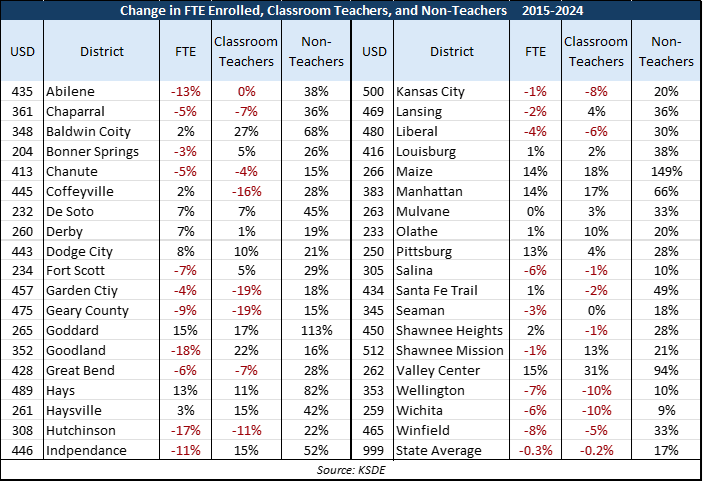Some Kansas school districts are facing tough budget decisions this summer with deficits on the horizon, and the reasons are largely self-inflicted. The Kansas Association of School Boards and some state education officials try to blame the Legislature for not providing more special education funding, but school districts’ budget files show that that isn’t the issue.
-School districts collectively lost 3,056 students in the just-ended school year, but they added 1,772 more employees. Employment has outpaced enrollment for a long time, which eventually can lead to budget deficits.
Since 2005, full-time equivalent enrollment only increased by 4.5%, while district employment jumped more than 17%.
School districts hired 5.3% more classroom teachers and 16% more special education teachers. Non-teachers, however, account for the most significant gains; the number of managers and other non-teachers shot up more than 28%.
School funding is largely based on enrollment, so districts that add staff at a faster pace than enrollment grows set themselves up for eventual budget challenges, and deficits sneak up pretty quickly if enrollment declines. Some districts also used one-time COVID relief money to hire staff and fund other ongoing expenses, and those bad decisions are coming home to roost now that the one-time federal money is going away.
There isn’t a ‘right’ employment mix between teachers and non-teachers, especially because the needs vary from one district to the next. Resources must be allocated to maximize student outcomes, and some employees have a much greater impact than others.
The Kansas Department of Education Accounting Handbook says Instruction – costs associated with the direct interaction between students and teachers – is “the most important part of the education program, the very foundation on which everything else is built. If this function fails to perform at the needed level, the whole educational program is doomed to failure regardless of how well the other functions perform.” (emphasis added)
School board members must decide whether district resource allocations between the Instruction cost center and all others are improving student outcomes at the pace needed to attain the goal for each school. In most cases, the answer is an emphatic “no.”
Employment increases cause deficits but don’t translate to achievement gains
Preliminary 2024 state assessment results for each grade tested are just slightly better than the prior year, and the state overall average to be released in October will likely still show a third of students below grade level and only a third proficient in reading and math.
Even with the marginal gain from last year, student achievement levels remain considerably lower than in 2015 despite a funding increase exceeding $2 billion. (2015 was the first year that the current state assessment was administered, and it cannot be compared to previous assessments.)
The percentage of students below grade level in reading and math increased in each instance, and most proficiency levels were lower than in 2015. The number of full-time equivalent students and classroom teachers is about the same as in 2015, but the number of non-teachers jumped 17%.

Some districts reduced non-teacher employment commensurate with 2015-24 enrollment declines, like USD 501 Topeka (-9% enrolled, -3% non-teachers) and USD 202 Turner KC (-6% enrolled, -12% non-teachers).
However, many districts added many non-teachers despite enrollment declines, as shown in the table below. Abilene, for example, lost 13% of its students but hired 38% more non-teachers. Such disparities are bound to lead to budget deficits.
There may be some circumstances in which employment changes were influenced by a district joining or departing from a special education cooperative.
Employment and enrollment changes for each district between 2015 and 2024 are available at KansasOpenGov.org.





